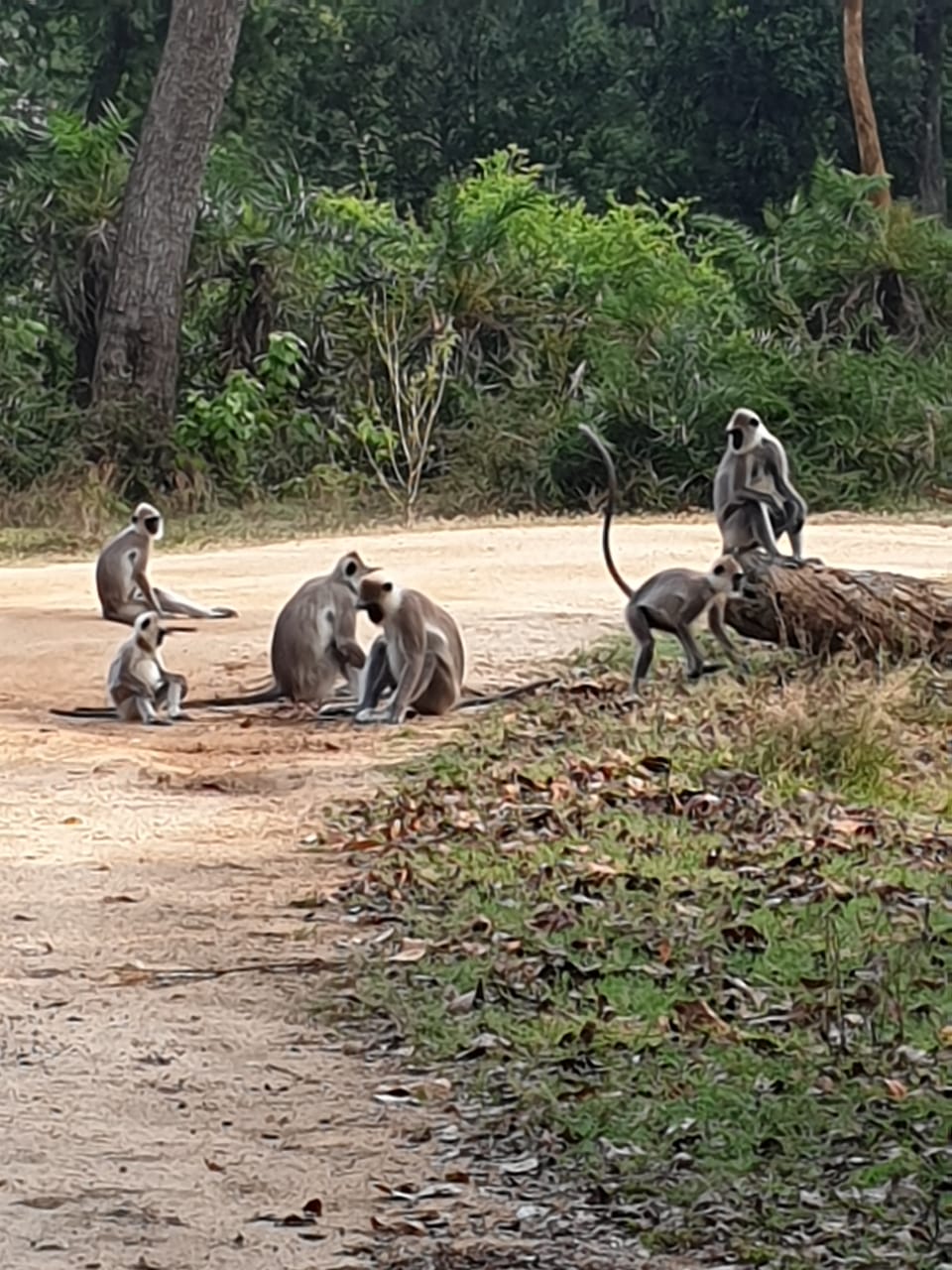Our National Parks
From Us to You...
A guide to help you choose a park for your safari experience. Explore the below lists of species and useful information about the beautiful National Parks in the area. If you wish to see elephants, Udawalawe and Yala are great choices. If you are all about birds, we highly recommend a visit to Bundala. Get in touch if you need more information!
Udawalawe National Park
Udawalawe National Park is a national park on the boundary of Sabaragamuwa and Uva Provinces in Sri Lanka. The reserve covers 30,821 hectares (119.00 sq mi) of land area and was established on 30 June 1972.The park has an annual rainfall of 1,500 millimetres (59 in),[2] most of which falls during the months of October to January and March to May. The average annual temperature is about 27–28 °C (81–82 °F), while relative humidity varies from 70% to 83%.
Udawalawe is an important habitat for water birds and Sri Lankan elephants. It is a popular tourist destination and the third-most visited park in the country.
Species recorded from the park include 94 plants,21 fish, 12 amphibians, 33 reptiles, 184 birds (33 of which are migratory), and 43 mammals. Additionally 135 species of butterflies are among the invertebrates found in Udawalawe.
Udawalawe is an important habitat for Sri Lankan elephants, which are relatively hard to see in its open habitats. Many elephants are attracted to the park because of the Udawalawe reservoir, [2] with a herd of about 250 believed to be permanently resident.
Mammals
- rusty-spotted cat
- fishing cat
- Sri Lankan leopard
- Sri Lankan axis deer
- Indian muntjac
- Sri Lankan spotted chevrotain
- wild boar
- water buffalo
- Golden jackal
- Asian palm civet
- toque macaque monkey
- tufted grey langur monkey
Birds (Udawalawe is also a good birdwatching site)
- Sri Lanka spurfowl
- red-faced malkoha
- Sri Lanka grey hornbill
- brown-capped babbler
- Sri Lanka junglefowl
- White wagtail
- black-capped kingfisher
- spot-billed pelican
- Sri Lankan sambar deer
- Asian openbill
- painted stork
- black-headed ibis
- Eurasian spoonbill
- white-bellied sea eagle
- crested serpent-eagle
- grey-headed fish eagle
- booted eagle
- changeable hawk-eagle
- Indian roller
- Indian peafowl (peacock)
- Malabar pied hornbill
- pied cuckoo
Reptiles and fish
- Oriental garden lizards
- painted-lip lizards
- mugger crocodiles
- Asian water monitors
- Bengal monitors
- 30 species of snake are found in the park
- Garra ceylonensis is an endemic fish species recorded in park
- Introduced Oreochromis spp., giant gourami, catla, and rohu are important food fish species found in the reservoir
Yala National Park
Yala National Park is the most visited and second largest national park in Sri Lanka. The park consists of five blocks, three of which are now open to the public. There are also two adjoining parks, Kumana National Park or 'Yala East' and Lunugamvehera National Park. The blocks have individual names, such as Palatupana (Block 1). It is situated in the southeastern region of the country, in the Southern Province and Uva Province. The park covers 979 square kilometres (378 sq mi) and is located about 300 kilometres (190 mi) from Colombo. The park is best known for its variety of wildlife and is important conservation of Sri Lankan elephants, Sri Lankan leopards and aquatic birds. 44 species of mammals are resident in Yala National Park, and it has one of the highest leopard densities in the world.
The national park is situated in the dry semi-arid climatic region and rain is received mainly during the northeast monsoon. The mean annual rainfall ranges between 500–775 millimetres (19.7–30.5 in) while the mean temperature ranges between 26.4 °C (79.5 °F) in January to 30 °C (86 °F) in April. It is windier in Yala, during the southwest monsoon compared to the wind during the northeast monsoon with wind speeds from 23 kilometres per hour (14 mph) to 15 kilometres per hour.
Mammals- Sri Lankan elephant
- Sri Lankan sloth bear
- water buffalo
- Toque macaque
- golden palm civet red slender loris fishing cat
- Reptiles
- Sri Lankan krait
- Boulenger's keelback
- Sri Lankan flying snake
- painted-lip lizard
- Wiegmann's agama
- Bahir's fan-throated lizard
- sea turtles (leatherback turtle, olive ridley, loggerhead sea turtle, hawksbill turtle, and green turtle)
- mugger crocodile
- saltwater crocodile
- The Indian cobra and Russell's viper are among the other reptiles.
Birds
- Eagles
- Kingfisher
- Sri Lanka spurfowl
- red-faced malkoha
- Sri Lanka grey hornbill
- Sri Lanka junglefowl
- White wagtail
- black-capped kingfisher
- spot-billed pelican
- Asian openbill
- painted stork
- black-headed ibis
- Eurasian spoonbill
- brown-capped babbler
- white-bellied sea eagle crested serpent-eagle grey-headed fish eagle
- booted eagle
- changeable hawk-eagle
- Indian roller
- Indian peafowl (peacock)
- Malabar pied hornbill pied cucko
Lunugamvehera National Park
Lunugamvehera National Park serves as a corridor for elephants to migrate between Yala National Park and Udawalawe National Park. Lunugamvehera is in the Dry zone of Sri Lanka, therefore the park is exposed to annual drought, relieved by the south western monsoon. The elevation of the park is 91 metres (299 ft). Out of 23,498 hectares of total land area 14 percent, that is 3283 ha, is land under the reservoir. Another 50 ha are two smaller reservoirs. Nearby Thanamalvila area receives a 1,000 millimetres (39 in) of annual rainfall. Rainfall decreases from North to South and West to East across the national park. Mean annual temperature of Lunugamvehera is 30 °C (86 °F.
Mammals- Elephant
- leopard
- Wild boar
- Spotted deear
- Mongoose
- Golden jacal
- grey heron
- black-headed ibis
- Asian openbill
- painted stork
- spot-billed pelican
- Kingfisher
- Eagles
Bundala National Park
Bundala National Park is an internationally important wintering ground for migratory water birds in Sri Lanka. Bundala harbors 197 species of birds, the highlight being the greater flamingo, which migrate in large flocks. Bundala was designated a wildlife sanctuary in 1969 and redesignated to a national park on 4 January 1993. In 1991 Bundala became the first wetland to be declared as a Ramsar site in Sri Lanka. In 2005 the national park was designated as a biosphere reserve by UNESCO, the fourth biosphere reserve in Sri Lanka.
The climatic conditions are tropical monsoonal, with a mean annual temperature of 27 °C (81 °F). Annual rainfall ranges from 900–1,300 millimetres (35–51 in), with dry period persists from May to September. The elevation of the park ranges from sea level to 10 metres (33 ft).
The Bundala National Park has been identified as an outstanding Important Bird Area in the South Indian and Sri Lankan wetlands. 324 species of vertebrates have been recorded in the national park, which include 32 species of fish, 15 species of amphibians, 48 species of reptiles, 197 species of birds and 32 species of mammals. 52 species of butterflies are among the invertebrates.The wetland habitats in Bundala harbours about 100 species of water birds, half of them being migrant birds. Of 197 avifaunal species 58 are migratory species.
Mammals
- elephants
- macaque monkey
- jackal
- leopard
- fishing cat
- mongoose
- wild boar
- mouse deer
- Tragulus meminna
Birds
- greater flamingo
- Waterfowl (lesser whistling duck Dendrocygna javanica, garganey Anas querquedula)
- cormorants (little cormorant Phalacrocorax niger, Indian cormorant P. fuscicollis)
- large water birds (grey heron Ardea cinerea, black-headed ibis Threskiornis)
- melanocephalus (Eurasian spoonbill Platalea leucorodia, Asian openbill Anastomus oscitans, painted stork Mycteria leucocephala)
- medium-sized waders (Tringa spp.)
- small waders (Charadrius spp.)
- Black-necked stork
- lesser adjutant
- javanicus
- Eurasian coot
- Kingfisher
Discover wildlife with us!
.jpg?width=1100&height=1467&name=caption%20(2).jpg)
Painted Stork
.png?width=960&height=1280&name=Untitled%20design%20(6).png)
Sri Lankan Elephant

Gray Langur
Customer review
“Just finished our 6-hr morning safari with Sanda. Had a wonderful time. We were picked up promptly and managed to be one of the earliest to enter the national park. Sanda was a good driver and very knowledgeable about everything we saw from the big mammals and crocodiles, to a huge number of birds. He seemed passionate about what he did too, which was nice. Would use again next time."
Would recommend 100%”
Need a taxi or transfer arranged?
We are here to help you!
